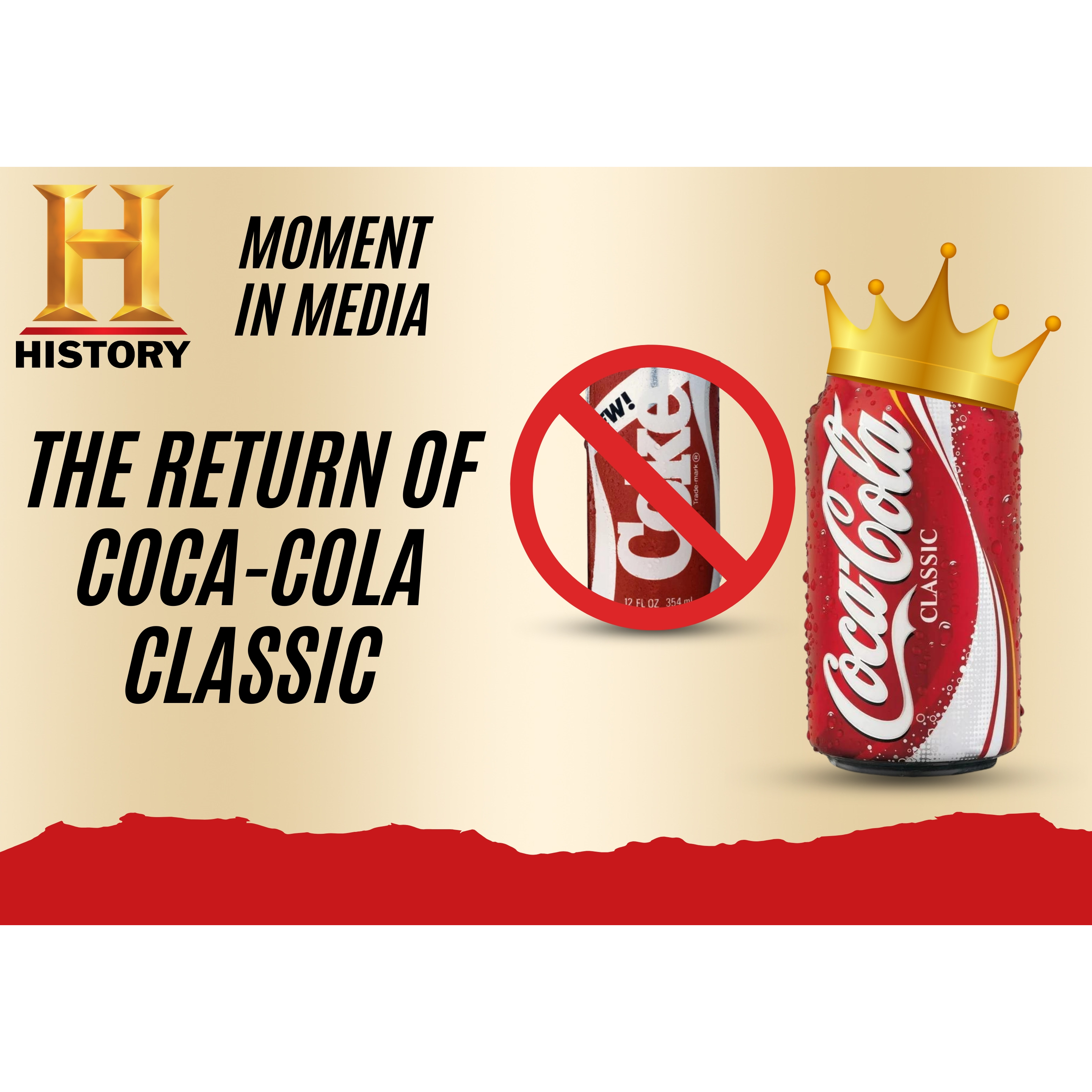HISTORY's Moment in Media: The Return of Coca-Cola Classic

July 10, 1985. On a Wednesday afternoon 39 years ago, ABC broke into its top-rated soap opera, General Hospital, with anchorman Peter Jennings and some breaking news: The Coca-Cola Company just announced it would bring back its original soft-drink recipe and call it Coca-Cola Classic.
It was the death knell for New Coke, which had launched with great fanfare only 79 days earlier. It was also the beginning of the end of one of the worst self-inflicted marketing disasters in American corporate history. In the end, though, the blunder served its own marketing purpose: It reminded Americans of their emotional connection with the traditional taste of Coca-Cola, it drove a boost in sales, and it helped the brand cement its position as the number one soft drink in the country.
In fact, the real risk that The Coca-Cola Company could lose that title was what initially drove the radical move of changing the cola's iconic flavor and top-secret recipe.
Coke was developed in 1886 by an Atlanta pharmacist, who then sold his special formula to another Atlantan, an entrepreneur named Asa G. Candler. This was a time long before supermarkets or most mass production; sodas were predominantly sold at soda fountains in small local pharmacies. Thanks to Candler's aggressive crew of salesmen, soda fountains across the country were soon selling Coca-Cola. By 1895, it was available in every state in the union, in both big cities and small-town pharmacies.
The transformation of America after World War II also altered the soft-drink business. People moved to the suburbs in huge numbers, and supermarkets began to replace small-scale independent grocers, offering a vastly wider variety of choices. That made it easier for rivals, like Pepsi-Cola, to gain market share. In 1948, Coke owned 60 percent of its market; by 1984, it was down to 21.8 percent. And Pepsi had grown its share to 18.8 percent.
That worried Coca-Cola executives who saw where the trend lines were going and could not afford to lose their number one status. They also were egged on by Pepsi's wildly successful Pepsi Challenge ad campaign, launched in 1975, which kicked off the so-called "cola wars." Years of TV commercials featured blind taste tests in which regular Americans picked their favorite drink and then learned it was Pepsi. Pepsi's recipe had more sugar than Coke's, and people preferred the sweeter soda.
Spooked by the results, The Coca-Cola Company got to work. Internal research -- nearly 100,000 more blind taste tests, they said -- reached the same conclusion: sweeter was more popular. At New Coke's press kickoff, held at Lincoln Center in Manhattan, Coca-Cola chairman and CEO Roberto Goizueta described the new recipe as "smoother, rounder, yet bolder -- a more harmonious flavor." What he didn't say was that it tasted more like Pepsi.
And what he could not have predicted was that America would rebel. In fact, he had predicted the opposite: "Some may choose to call this the biggest single marketing move in the history of the packaged goods business. We simply call it the surest move ever made."
The Coca-Cola Company's stock price dropped. Pepsi took out newspaper ads declaring victory in the cola wars. Angry calls started rolling into Coca-Cola headquarters and to their network of independent bottlers. At the peak of the cola wars, Atlanta HQ reported 8,000 calls per day. Protest groups sprung up with names like Old Cola Drinkers of America. Devotees began stockpiling the cans and bottles they could still find of the old Coke.
It was clear that The Coca-Cola Company had miscalculated. One problem was that because the recipe development of New Coke was a top-secret project, all those taste tests simply asked whether people preferred one taste to another -- but never considered the drinker's emotional or nostalgic connection to the old Coca-Cola. Another theory is that the consumer research didn't consider how people actually drink Coca-Cola: a sweeter sip might be the top pick in a very small dose, but in a tall glass and alongside a meal, it could be overwhelming.
Within weeks, it was clear that it was time for a retreat. The old recipe, dubbed Coca-Cola Classic, was pulled out of its bank vault, and relaunched on that July afternoon. (New Coke lived on for a bit as Coke II and was eventually discontinued.) Reminded of how much they liked the old standby, Americans started buying Coca-Cola Classic in greater numbers, and market share rebounded. Today, The Coca-Cola Company, across all its brands, is the biggest marketer in its industry, with about $4 billion of ad spend each year. It also controls about 43 percent of the soft-drink market. Coca-Cola Classic is still number one.
Because of that ultimate success, there have long been rumors that the New Coke launch was a marketing stunt, a brilliant fake-out. A careful review of the history shows that it wasn't the case at all. Or, as the company's then-president, Donald Keough, once commented: "Some critics will say Coca-Cola made a marketing mistake. Some cynics will say we planned the whole thing. The truth is we are not that dumb, and we are not that smart."
Click the social buttons to share this story with colleagues and friends.
The opinions expressed here are the author's views and do not necessarily represent the views of MediaVillage.org/MyersBizNet.

